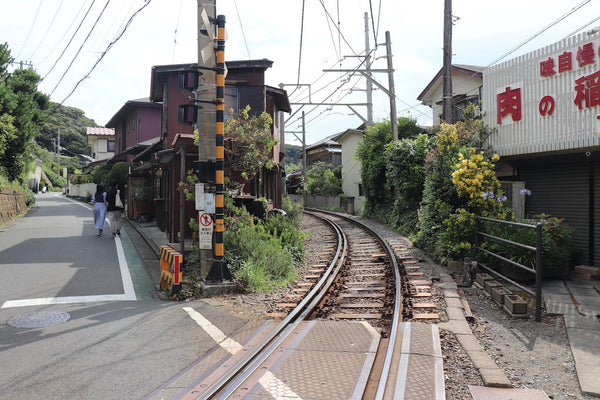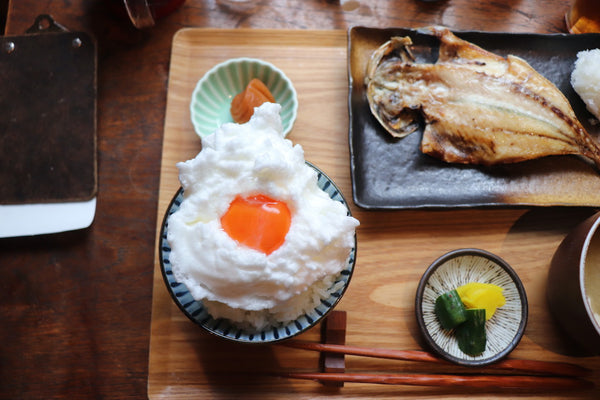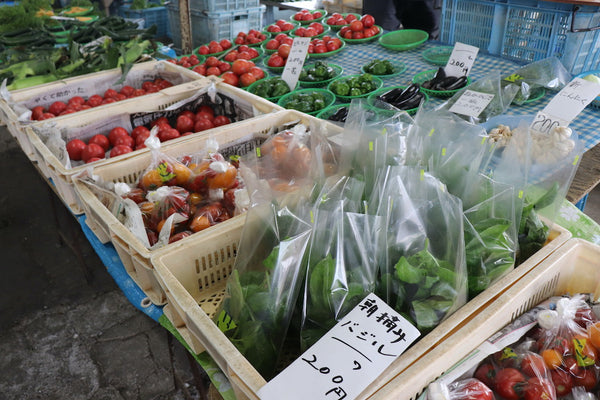Kamakura: An Ancient City of Tradition and Modernity PART I: A Day of Eating and Bento Making

Scenic Enoden (Enoshima Electric Railway) connecting Kamakura and Fujisawa | MARY HIRATA MCJILTON
Kamakura
Located in Kanagawa Prefecture, Kamakura is a historic coastal town only an hour away from Tokyo. Known for its well-preserved historical buildings, the ancient city attracts an average of 20 million visitors annually from Japan and abroad. In recent years, it has become a destination for young people and families to escape from the crowded city of Tokyo and to relocate to a mid-sized town with abundant nature within walking distance from the city center.
The history of Kamakura dates back to the year 1185 when the first Kamakura shogunate, Minamoto no Yoritomo, defeated the Taira clan and claimed Kamakura as a center of governance, culture, and commerce. Protected by the surrounding mountains, this was the first time in history that shogun warriors governed Japan and they ruled for 148 years.
During the Kamakura period, foreign relations with China were also developed, which introduced new knowledge, styles and customs such as Zen Buddhism. Today, more than 80 historical sites are found just within the city of Kamakura, with the vast majority being temples and shrines.

There are many historical sites, some are visible and some are hidden | MARY HIRATA MCJILTON
Many popular tourist destinations are located on Komachi Dori (Komachi Street) - a 350m long street lined with local food and souvenirs shops, and cafes. The end of the road takes you to the Tsurugaoka Hachimangu shrine, the most significant shrine in Kamakura.

A narrow railway going through the residences along the Shonan area | MARY HIRATA MCJILTON
7:00 am - Breakfast at Yoridocoro in Kamakura

The nostalgic house where Yoridocoro is open daily | MARY HIRATA MCJILTON
Yoridocoro offers breakfast, lunch, and snacks in a nostalgic house facing the Enoden railway. It attracts guests from all around, who often wait in line for their chance to eat here.

This is where everything begins | MARY HIRATA MCJILTON
Yoridocoro’s a traditional teishoku Japanese meal-set that includes miso soup, rice, a side dish, pickles, and a choice of grilled dried-fish, which can be enjoyed on the patio overlooking the Enoden railroad or in the traditional tatami mat area with low tables and square cushions for sitting on the tatami floor.
Although Teishoku was once an everyday breakfast for many in Japan, it has become less common as more people prefer a quick, convenient meal. But Yoridokoro is different. People wake up early to have breakfast at Yoridocoro for the nostalgic feeling it offers.

15 minutes later… I told myself, "Don’t give up!" | MARY HIRATA MCJILTON
Breakfast menu options:
Tamago Kake Gohan (Rice topped with a fresh raw egg)
Aji Himono Teishoku (Grilled dried horse mackerel set)
Saba Himono Teishoku (Grilled dried mackerel set)
ASA (Horse mackerel and mackerel combined)
Lunch offers more varieties of fish with different types of seasoning, such as salted or Japanese-style sautéed with mirin, sake, and soy sauce.

Fluffy egg white | MARY HIRATA MCJILTON
I ordered the Aji Himono Teishoku with a side dish of umeboshi (Japanese pickled sour plum) and Yoridocoro's famous kodawari tamago ("fluffy cloud egg"). Kodawari tamago is a popular side dish of cloud-like, foamed egg whites, which adds a delightful texture to rice.
While I waited for my meal, I received a guide explaining how to make the "perfect" egg white foam. I nervously cracked the eggshell and separated the egg yolk and the egg white. The instructions said it would take about 20 minutes of constant whisking to create the beautiful foam. I excitedly whisked the egg white in all sorts of directions and angles, and as the clock passed the 20 minute mark, my egg white was still liquid. It took 30 minutes of intensive whisking for the egg white to turn into foam, but was worth the effort.

After 30 minutes of intensive whisking, the egg white turned into foam | MARY HIRATA MCJILTON
My meal arrived arranged on a tray, bringing back memories of my grandmother who woke up early every morning to make a traditional Japanese breakfast just like this. The aji was crispy with a smoky aroma. Its meat was juicy and light with a hint of salt, and paired well with rice, while the miso soup was made from mugi (barley) miso. I then poured some sweet soy sauce onto my fluffy egg white and mixed it with a chopstick full of rice. The taste of this tamago kake gohan was sweet, salty, and rich, as tiny bubbles popped inside my mouth,

"Itadakimasu" – a perfect breakfast using simple ingredients | MARY HIRATA MCJILTON
Website: https://yoridocoro.com/
Address: 1 Chome-12-16 Inamuragasaki, Kamakura, Kanagawa 248-0024
10:00-12:00 - Bento making experience with Kamakura Mind

Founder of Kamakura Mind, Matsuzaki-san (right), and the bento-making coordinator, Suenaga "Sue"-san (left) | MARY HIRATA MCJILTON
Kamakura Mind offers local tours and cultural experiences that are unique to Kamakura for both Japanese and non-Japanese speakers, and include private tours of temples, historical sites, nature walks, and cultural immersions, such as zazen (tea ceremony), hanko (seal) making, and chopstick carving, all taught by the Kamakura locals.
The founder of Kamakura Mind, Yukiyo Matsuzaki Smith, spent years in the US where she and her family enjoyed being surrounded by nature. After moving back to Japan, they chose to live in Kamakura as it offers both the convenience of easy access to Tokyo and the peacefulness of nature. Yukiyo quickly immersed herself in the community by volunteering at cultural events and with the help of the locals, was then inspired to start her own business, Kamakura Mind.

Shopping lists are given to guests to purchase ingredients for the bento making experience | MARY HIRATA MCJILTON
I had the honor of participating in their "Bento making experience", hosted by Suenaga "Sue"-san, using local vegetables purchased at Kamakura's oldest farmers market known as Renbai. Influenced by European farmers markets, Renbai opened in 1928 and is known as the birthplace of Kamakura vegetables.

Finding Kamakura's fresh vegetables for the bento making experience | MARY HIRATA MCJILTON
Kamakura Mind provides an authentic, memorable experience for their guests by giving them a shopping list of ingredients and allowing them to engage with farmers, pay with Japanese coins, and discover local vegetables.

Guests can ask questions directly or communicate through the Kamakura Mind coordinator for tips and recommendations | MARY HIRATA MCJILTON
We then took a train to Kita-Kamakura station, where the bento workshop is held at a community studio, Takarano Ni Wa. Kita-Kamakura is a hidden gem of Kamakura with several temples, local restaurants, and beautiful houses found along the winding, green roads.

Listening to Sue's lecture | YUKIYO MATSUZAKI SMITH
We took a short break at Tea House Houan. Designed by an architect, Bunzo Yamaguchi, Houan was built in 1934 and incorporates modernism into the traditional teahouse.
After our break, we walked up to the 85-year-old house (now used as the main building within the property) and entered the cozy brick space as Sue explained the menu and plan for the workshop.

All thanks to Sue, who I wish I had as my neighbor | MARY HIRATA MCJILTON
Make your own bento box:
Onigiri (rice ball) – corn, rice, salted plum
Tsukemono (pickles) – cucumber, radish, Sue's homemade shiso (red Japanese basil)
Tamagoyaki (Japanese omelet) – egg, sugar, salt, dashi (broth)
Tempura – zucchini, yukinoshita (strawberry geranium)
Karaage – fried marinated chicken
Gomaae – boiled green beans with a sesame dressing
Nimono – simmered potatoes
Misoshiru (miso soup) – tomatoes, mitsuba from the garden, knobu (kelp) dashi

Sue showing how to flip the tamagoyaki using chopsticks | MARY HIRATA MCJILTON
We first learned how to make tempura using rice flour and rice bran oil which lightly fries the batter while not overpowering the taste.

Preparing the tamagoyaki (Japanese egg omelet) | YUKIYO MATSUZAKI SMITH
Sue showed us how to remove the excess batter using the side of the bowl, which is key to making a light, crisp tempura. I then saw some unfamiliar leaves shaped like hearts with a streak of white veins. Sue-san kindly explained that these were strawberry geraniums (or yukinoshita in Japanese), edible wild plants often found on mountains and excellent for having as tempura.

Rolling the tamagoyaki using the traditional Japanese egg pan | YUKIYO MATSUZAKI SMITH

A discovery! Who would've thought tomatoes and miso soup go well together? | MARY HIRATA MCJILTON
Cooking tips from Sue:
Tamagoyaki (Japanese egg omelet)
- Use minimal oil, only a brief wipe of oil-soaked paper towel is sufficient, before pouring the beaten eggs.
- Beat the eggs thoroughly to give them an even, light yellow color.
Onigiri (rice ball) with corn
- Simmer the rice with the corncob to diffuse the flavor into the broth and to create a deeper taste.
- Corn silk has good nutritional value, so be sure to cook them together with rice.
Misoshiru (miso soup) with tomatoes
- Adding tomatoes to miso soup gives it a rich flavor, transforming a Japanese dish into something similar to a vegetable soup stock.

Using naturally grown leaves for decorating the bento | YUKIYO MATSUZAKI SMITH
After the cooking was done, it was time to pack the food into a bento box made of bamboo sheaths prepared by Kamakura Mind. Bamboo is very durable and it was heartwarming to receive such a well-crafted bento box.

Picked some additional flowers to decorate the bento | YUKIYO MATSUZAKI SMITH
We then explored the garden to find leaves and flowers to decorate our bento boxes. Sue showed us some of the herb and vegetable gardens where some of the herbs in our bento were grown.

Part of the garden | YUKIYO MATSUZAKI SMITH
Listening to the birds as we walked down the brick steps and exploring the greenery made me appreciate the beautiful nature Kamakura has to offer.

Finalizing my bento using leaves and flowers | YUKIYO MATSUZAKI SMITH

Ta-da! My beautiful bento box! | MARY HIRATA MCJILTON
After all the items were neatly and tightly packed, we celebrated our successful work of making a beautiful bento. Under the gentle sunlight shining through the tall branches, I sat in the fresh air, inhaled deeply, and said, “Itadakimasu" – a customary phrase said before eating a meal in Japan.

A wonderful time spent in such a short time. | MARY HIRATA MCJILTON
Website: https://www.kamakuramind.com/
Address: 4 Chome-3 Inamuragasaki, Kamakura, Kanagawa 248-0024
6:00 PM - Dinner at Kamakura Matsubara-an

Noren, traditional Japanese shop curtain, swings gently with the wind as it greets guests |MARY HIRATA MCJILTON
A short walk from Yuigahama station is a beautifully preserved traditional Japanese house serving fresh homemade soba noodles and locally grown food.
Entering through the noren (traditional Japanese shop curtain), a server welcomed me inside and as I took off my shoes, I entered the restaurant and it felt like walking into a "home."

Engawa, a traditional Japanese hallway architecture, that connects to the outdoor patio | MARY HIRATA MCJILTON
I decided to eat in the traditional Japanese dining area, where I happened to have the room to myself. The cozy tatami room fits four lower tables, seating two to four people per table. While I waited for my order, I took in my surroundings, noticing the refined look of the architectural design.

Traditional tatami mat seating feels like home | MARY HIRATA MCJILTON
Matsubara-an serves handmade soba noodles that are made every day so guests can experience fresh noodles. Their soba noodles are thinly cut ni-hachi soba, made in the Edo-mae style, which uses buckwheat flour and a binding agent of wheat flour in an 8:2 ratio (ni means two and hachi means eight in Japanese). They also offer side dishes of tempura, sashimi, and grilled food using locally sourced fish and vegetables from Kamakura.

Appetizer of summer asparagus tempura with freshly squeezed lemon | MARY HIRATA MCJILTON
I happened to visit the restaurant amid the rainy season when the humidity was at its peak. I decided to order their specialty summer asparagus tempura as an appetizer and the cold sudachi oni oroshi soba as a main. The asparagus tempura came with a slice of lemon, which was interesting as I was only used to having tempura with a soy sauce-based dipping sauce or salt. The fresh squeezed lemon juice diffused a refreshing aroma as I poured it on top of the hot tempura. Although the asparagus was surprisingly large, it was cooked to the core, giving it a natural sweetness, while the hint of lemon made the tempura taste heavenly.
The sudachi oni oroshi soba was covered in slices of sudachi, a small lime-like Japanese citrus fruit, and garnished with big chunks of shredded daikon, Japanese white radish. Oni oroshi is a popular cooking technique named after the bamboo grater blade that looks like the teeth of a Japanese oni (ogre). The rough blades prevent the daikon from losing its moisture while maintaining its texture and creating a mildly-flavored garnish perfect for cold soba. The sudachi, on the other hand, was sliced paper-thin, making it easy to slurp together with the noodles, and adding a zesty, sharp taste.

Sudachi oni oroshi soba in which sliced sudachi adds zest to simple cold soba noodles | MARY HIRATA MCJILTON
Website: https://matsubara-an.com/shops/kamakura.php
Address: 4-10-3 Yuigahama Kamakura Kanagawa
After a day of eating and bento making in Kamakura, here are some sites to visit, delicious quick bites to enjoy and souvenirs to pick up while in Kamakura.
[Author Profile]

Born and raised in Japan, Mary Hirata McJilton is a graduate of the University of Minnesota. While earning her degree in Global Studies and a minor in Political Science, she worked at a Japanese restaurant, was actively involved in a Japanese student group that hosted Japanese food events, and interned at Slow Food Minnesota. These experiences nurtured her curiosity around food culture and sustainability. With characteristic serendipity, she spontaneously meets new people wherever life takes her, expanding her repertoire of original Mary-stories that she loves to share over meals. In her downtime, she enjoys cooking with herbs and vegetables that she grows herself on her cozy balcony, and refreshing the Italian she learned from a stint studying abroad.




